The “Monarch of Bermuda” and the “Queen of Bermuda” are two large British liners that run regularly between New York and Bermuda. This special service has definite characteristics which govern the design of luxury liners for the run.
WORLD’S LARGEST SHIPS - 8
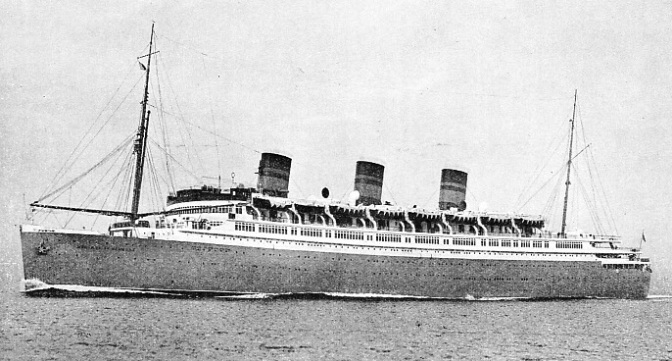
FIRST OF THE TWO FAMOUS LINERS that link New York with Bermuda, the Monarch of Bermuda was built at Newcastle-on-Tyne in 1931. A quadruple-screw electric ship of 22,424 tons gross, she has a length between perpendiculars of 553 ft 2 in, a beam of 76 ft 7 in and a depth of 39 feet, with a load draught of 27 ft 1 in.
The Monarch of Bermuda and the Queen of Bermuda are all- electric from stem to stern, from propelling motors to bacon slicers.
The two vessels are enormous yachts, capable of cruising in comfort all round the world. They are the two largest and most important ships which are owned in Great Britain and operated under the Red Ensign but yet run regularly out of the port of New York, which is their base.
The work on which they are engaged is unique. It is interesting to note the way in which the Bermuda traffic has been built up. The Monarch of Bermuda and her sister ship the Queen of Bermuda carry passengers outwards and a cargo of water, because Bermuda is short of water.
They bring passengers and fresh vegetables homewards from the p group of Atlantic islands which are known as the Bermudas.
Furness, Withy and Company Limited acquired an interest in this trade shortly after the war of 1914-18. The company began the present service with the Bermudian - renamed Fort St. George - and with two other steamers built for the Australian trade and renamed Fort Victoria and Fort Hamilton. The Fort Victoria was sunk off New York without loss of life, the Fort Hamilton was sold to Italian owners and the Fort St. George was scrapped. Bermuda is a favourite holiday resort of the Americans. It bears almost the same relationship to New York as Honolulu does to San Francisco. In about the same latitude as Charleston, South Carolina, Bermuda enjoys a tropical climate because of its position in the direct sweep of the Gulf Stream. The island is 720 miles from Halifax, Nova Scotia, 660 miles from New York and 568 miles from Cape Hatteras (North Carolina), the point at which north-coming passengers from the tropics put on their overcoats. Bermuda is a British naval station, a coaling and an oil bunkering depot.
The group of islands has a combined land and water area more than five times the land area. The principal town and harbour is Hamilton. This is the terminus of the Furness-Bermuda Line services from New York, although a call is made at St. George on the outward voyage. The entrance to Hamilton is extremely winding and tortuous. One of the prime requirements for any large ship regularly operating to the island is extensive power of manoeuvre. In the Monarch of Bermuda and the Queen of Bermuda, therefore, four screws are used and electric motors drive each screw.
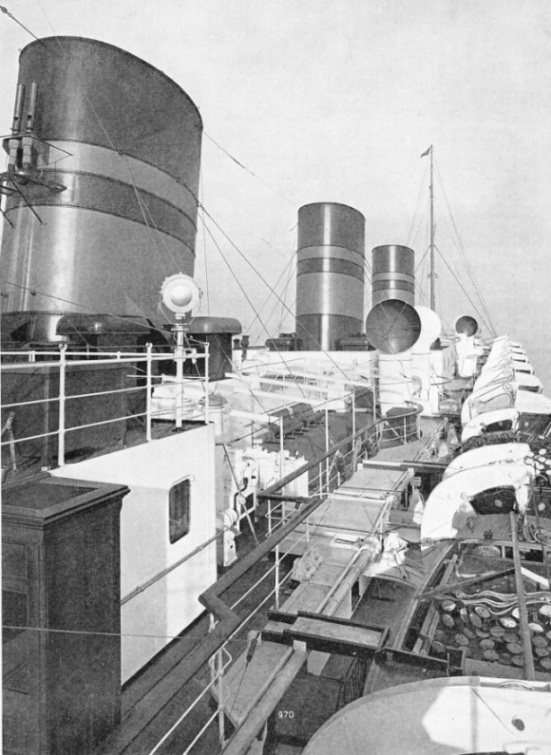
THE THREE FUNNELS of the Monarch of Bermuda, the Furness Withy luxury liner, are black, with one narrow and one wide band of deep red. This unusual photograph gives a striking impression of the liner’s boat deck and superstructure. Four electric motors developing 20,000 shaft horse-power drive the Monarch of Bermuda and her sister ship at about 19 knots.
Foreseeing the possibilities of increasing traffic to Bermuda, the Furness, Withy Line took delivery in January 1928 of a quadruple-screw motor vessel called the Bermuda. She had a gross tonnage of 19,070, a length of 525 ft 11 in and a draught of 26 ft 11 in. This ship had a speed of nearly 17 knots when using 56| tons of fuel oil a day, and her total power on the four screws was 11,250 brake horse-power at 110 revolutions of the shafts. At the time of her completion she was one of the most powerful motor vessels in the world and one of the few quadruple-screw units. The Bermuda was one of the unluckiest of ships. She caught fire in Hamilton, but was partly salved and sent home to her builders at Belfast for reconstruction. While there she caught fire again and became what the underwriters call a constructive total loss. Even then, when the fire-battered hulk was being towed away for breaking up, she grounded on the Scottish coast.
The Monarch of Bermuda was completed in 1931 as an improvement on the Bermuda, for the trade which was maintained during the refitting of the original Bermuda had been growing. It was then carried on with the existing old steamers Fort Hamilton and Fort St. George, assisted by chartered vessels which, however, were not altogether suited for the special work.
As a quadruple-screw electric ship, the Monarch of Bermuda was an immediate success. It was therefore decided to build her sister, the Queen of Bermuda. The differences between the Monarch of Bermuda and the Queen of Bermuda are, with one exception, of a minor nature. This exception is important because it involves in the newer ship the elimination of the lower swimming bath. Since in winter the ship leaves New York in cold weather and half-way to Bermuda reaches almost tropical heat, it was felt that passengers would appreciate a lower swimming bath for the first day and would prefer an upper deck bath for the second part of the voyage.
In the Monarch of Bermuda all available space is taken up by passenger accommodation. The portion of the ship left over for propelling machinery is therefore small. This was another reason for the choice of electric propulsion, which could be so conveniently and flexibly arranged in those parts not required for the passenger accommodation. So much passenger accommodation was required, that the lower swimming bath was arranged to occupy the space that in the Queen of Bermuda is the auxiliary engine-room.
Successful Endurance Trials
In the newer ship it was decided to eliminate this swimming bath so that more ample space was available. As with the Monarch of Bermuda, the contract for building the hull and for the steam portions of the machinery was obtained by Vickers-Armstrongs, who built her at their Barrow-in-Furness yard.
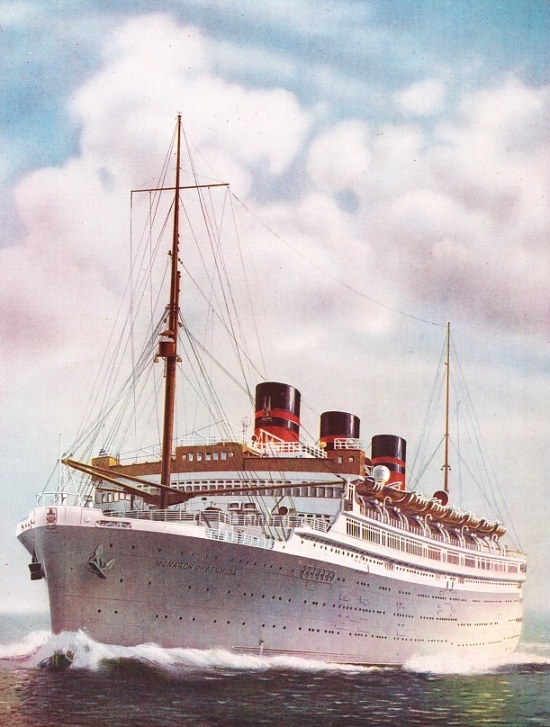
ALL-ELECTRIC FROM STEM TO STERN. The Monarch of Bermuda, the Furness Withy liner, of 22,424 tons gross, and her sister, the Queen of Bermuda, 22,575 tons gross, are luxury vessels, capable of cruising in comfort round the world. They are employed on the service between New York and Bermuda, which has long been a holiday resort favoured by Americans. The ships were built at Newcastle-on-Tyne and Barrow-in-Furness respectively. The Monarch of Bermuda has a length of 553 ft 2 in, a beam of 76 ft 7 in and a depth of 39 feet. Her sister ship has almost the same dimensions.
Work was started on the Queen of Bermuda at the beginning of 1932 and the ship left the basin of her builders at Barrow-in-Furness on February 10., 1933. Four days later the ship ran progressive speed trials in the Firth of Clyde on a measured mile, over which she reached a maximum speed of 21.07 knots and an average speed of 20.7 knots. Immediately after the speed trials she successfully completed her forty-two hours’ endurance trials.
The leading particulars and general characteristics of the Queen of Bermuda are as shown in the following table:
Length overall 579 ft 6 in.
Length between perpendiculars 553 ft 5 in.
Moulded breadth 76 ft 7 in.
Extreme breadth 83 ft 6 in.
Depth moulded to A Deck 59 ft 9 in.
Depth moulded to B Deck 51 ft 6 in.
Depth moulded to C Deck 43 ft 3 in.
Load draught 27 ft 1 in.
Gross tonnage 22,575
Speed 19½ knots
Shaft horse-power approximately 20,000.
The hull is of handsome external appearance, with its lofty white superstructure characteristic of the modem passenger liner. The cruiser stern, three black funnels with bands of deep red, two well-raked masts, the topsides with a green band at the water-line, a narrow white band above, and the remainder finished in French grey, give the vessel a striking appearance. As in the Monarch of Bermuda, electricity is used on the most extensive scale possible throughout the entire ship. It is used for the propulsion and steering of the vessel, for the lighting and ventilation of all the public rooms and cabins, for the refrigeration and cooking of food, for the handling of cargo, for the signalling and indicating devices and for the driving of the laundry machinery, gymnasium equipment and printing presses. The electrical equipment required for these purposes involved the manufacture of turbo-alternators, propulsion motors and control switchgear, auxiliary generating plant, and over 270 marine-type electric motors for auxiliary machinery totalling approximately 3,000 horse-power in capacity.
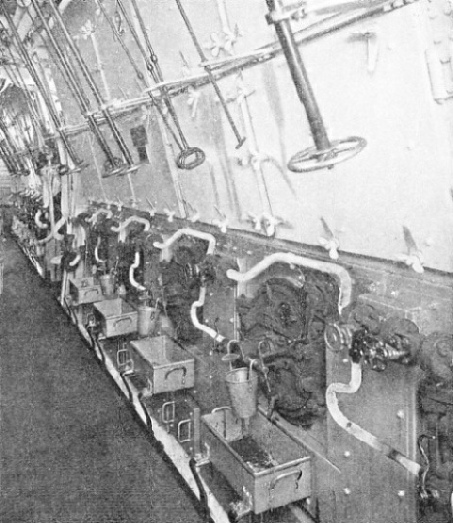
POWER FOR THE ELECTRIC PROPULSION of the Monarch of Bermuda is supplied by steam from eight water tube boilers arranged in groups of four in the boiler-rooms. The boilers burn oil and the steam generated drives turbines which are coupled to the electric generators. The current is led by cables to the stern of the ship, where it drives four motors which turn the four propellers.
The New York-Bermuda run is nothing more nor less than a long cross-channel service, although either ship is well capable of world cruising and one of them has already cruised from South America to New York. A strenuous schedule has ordinarily to be observed over a 660-miles run.
The Queen of Bermuda on one trip set up a new record on the New York-Bermuda run. She travelled from Sandy Hook, New York, to David’s Head, Bermuda, in 32 hours 48 minutes, at an average speed of 20.33 knots, thus beating by half a knot the previous record held by her sister ship the Monarch of Bermuda.
The vessels are noteworthy for big lofty public rooms and for the number of luxury suites, cabins with baths and other amenities of shipboard life.
Among the most interesting features are the dance floor and the swimming pool. The dance floor is arranged aft and has glazed sides which can be removed as and when necessary. Three-colours lighting is used for the main ceiling and the lighting is controlled by dimmers to give fading effects while dancing is in progress. Forward and aft of the dancing space are two veranda cafes of oriental character, with metal work cornices lacquered in Chinese red and with glazed bent panels of soft yellow relieved with bright lines. It is claimed that the lighting of the ships is carried out on lines even more lavish than is usually accorded to a modem first-class liner. As much as 450 kilowatts are required for the lighting of either ship. Particularly noteworthy because of its proportions is the first-class dining saloon, to which the architect has given an eastern atmosphere, with a well opening in the centre, giving increased height in this part of the room. Above the opening is an illuminated ceiling comprising a series of eight lay-lights; the metal work of each light is finished in black lacquer and each is glazed with tinted glass panels in delicate shades of yellow, green and white.
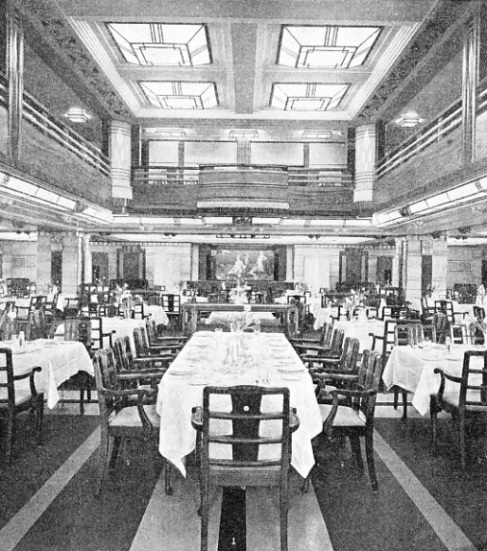
THE FIRST-CLASS DINING SALOON in the Queen of Bermuda has a well opening in the centre to give increased height and added illumination. An illuminated glazed cornice surrounds the foot of the opening and at the four corners glazed columns give additional light. A total of 3,000 kilowatts is used for auxiliary purposes.
An illuminated glazed cornice surrounds the well opening and is generally of a pale yellow colour, with a decorative feature glazed with green and red panels interposed at intervals. Additional light is provided by glazed columns at the four corners above the well. The lower ceiling is mainly lighted by indirect means from mirror reflectors concealed in the cornices, and shallow lay-light type fittings are fitted fore and aft. At the outboard is a series of boxed ceiling fittings, characteristic of the whole of the fittings in this room. The windows are floodlighted behind decorative glazed grilles.
Leading into the dining saloon is a large foyer, flanked with a cocktail bar on the starboard side. This foyer is considerably larger than that found in many bigger passenger liners. The first-class lounge is surrounded by an attractive gallery. Verandas open from the gallery and afford a view over the sea. At the lower level of the lounge the ceiling is divided into recessed bays.
Another handsome decorative feature is to be found in the smoking-room. This has a decorated upper ceiling, fitted with two lanterns which are outstanding examples of design and craftsmanship in electric fittings.
One important problem with which the architects of the Queen of Bermuda and the Monarch of Bermuda were faced was that of providing for ventilation and of countering the effects of the humid atmosphere encountered particularly in the Gulf Stream, which is crossed on the New York-Bermuda run. The cargo hold and some of the less important store-rooms in the ship take fresh air from the usual cowl type ventilators familiar on shipboard, but the whole of the accommodation is ventilated by what is known as the Thermotank system.
More than a hundred ventilating units are used, each incorporating a fan driven by a small motor. Large trunk-ways, cleverly concealed, are led all over the passenger accommodation. In many places these are big ball-and-socket joints which enable not only the direction of the air but also its temperature to be controlled. In addition to this all cabins are provided with fans.
The four screws are driven by electric motors which are nothing more nor less than the big brothers of the motor which drives a domestic refrigerator. Electricity was chosen for propelling the vessels because of its flexibility and the way in which the screws could be controlled. It was also selected because with an electric ship it is possible to place boilers, generators and turbines in almost any place required.
Thus in the Monarch of Bermuda and her sister ship there are altogether eight water tube boilers arranged in two groups of four in special boiler-rooms and separated the one from the other by another room which may be termed a power-generating space containing the turbo-generators, described below.
The boilers burn oil and generate steam. This steam is taken by pipes to turbines. The turbines are coupled to electric generators and in turning generate current which is led by cables to the four motors in the stern of the ship. There is no link between the turbo-generators and the propelling motors other than cables.
Electrical Equipment
Each propeller is separately operated by what is known technically as a synchronous motor of approximately 5,000 horse-power at 150 revolutions a minute. The four motors are supplied with current at 3,000 volts from two 7,500-kilowatts turbo-alternators, running at 3,000 revolutions a minute. It is possible by the provision of a simple system of switching to connect each of the propulsion motors to either of the two turbo-alternators. In normal circumstances, however, the ship functions in the same way as a twin-screw vessel, the two port propulsion motors operating in unison either ahead or astern from the port alternator and the two starboard motors operating in unison ahead or astern from the starboard alternator.
There are two turbo-generators arranged in an engine-room between the two boiler-rooms. Each turbine operates at 350 lb pressure and at 750° F. total temperature. Their height is not great because the deck overhead is brought down as low as possible to give extra passenger accommodation. The turbo-generators for supplying current for auxiliary power are arranged in the same compartment as the four main propelling motors. Each has an output of 750 kilowatts. The turbines are geared to the generators and run at 6,000 revolutions a minute; the generators run at 750 revolutions.
Each of the generators is what is known technically as an open compound-wound unit. The electricity that they generate is distributed to a main switchboard 60 feet in length.
Distribution of the direct current for auxiliary purposes is through eighteen panels; provision is made whereby, if anything goes wrong in the engine-room or with the load upon the generators, certain circuits of what is known as non-essential type automatically cut out. From this switchboard, too, goes current to the mighty hydraulic electric steering gear.
Such is the machinery which makes it possible for either of these two luxury liners to travel in the course of a normal year over 100,000 miles and to make about 150 arrivals and departures.
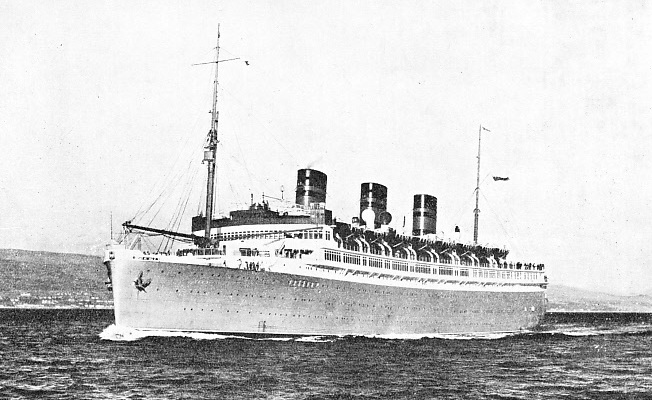
WITH A GROSS TONNAGE OF 22,575, the Queen of Bermuda is slightly larger than her sister. Built two years later, in 1933, she has an overall length of 579 ft 6 in, a beam of 76 ft 7 in and a load draught of 27 ft 1 in. Her propeller motors develop a shaft horse-power of about 20,000 and her quadruple screws drive her at a speed of over 19 knots.








